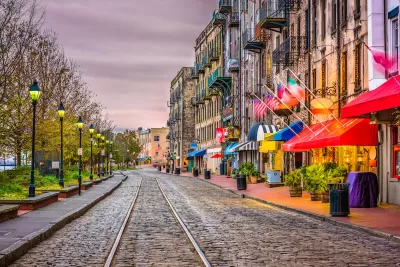From a human-scales, plaza-anchored grid to suburban sprawl, the oldest planned city in the United States has seen wildly different development patterns.

In a piece for Strong Towns, Edward Erfurt describes some lessons for urbanists drawn from the oldest planned city in the United States, Savannah, Georgia.
As Erfurt explains, “Savannah’s streets and blocks are organized around a series of squares” that divide parcels for private development. In the mid-20th century, urban renewal led to the destruction of older communities in favor of larger developments, eliminating some of the city’s historic walkability and human-scaled spaces.
As a result of these rapid and destructive changes, Erfurt argues, “Savannah is a city stuck in regulatory amber. All of the dramatic and radical change the city has experienced has hardened the position of residents to reject change.”
For Erfurt, Savannah is a great example of a city with “the full extremes” on the development spectrum, with historic areas revealing small-scale development patterns and sprawling suburbs. But modern mistakes shouldn’t freeze development in place, Erfurt writes. “Cities that are not exempt from change allow for the natural pattern of development to begin while restricting radical change. Allowing for small incremental changes, at scale, dispersed throughout the city, will thicken the historic grid of the city and continue Savannah’s success into the next 300 years.”
FULL STORY: Lessons on Development Patterns From America’s Oldest Planned City

Study: Maui’s Plan to Convert Vacation Rentals to Long-Term Housing Could Cause Nearly $1 Billion Economic Loss
The plan would reduce visitor accommodation by 25,% resulting in 1,900 jobs lost.

North Texas Transit Leaders Tout Benefits of TOD for Growing Region
At a summit focused on transit-oriented development, policymakers discussed how North Texas’ expanded light rail system can serve as a tool for economic growth.

Why Should We Subsidize Public Transportation?
Many public transit agencies face financial stress due to rising costs, declining fare revenue, and declining subsidies. Transit advocates must provide a strong business case for increasing public transit funding.

How to Make US Trains Faster
Changes to boarding platforms and a switch to electric trains could improve U.S. passenger rail service without the added cost of high-speed rail.

Columbia’s Revitalized ‘Loop’ Is a Hub for Local Entrepreneurs
A focus on small businesses is helping a commercial corridor in Columbia, Missouri thrive.

Invasive Insect Threatens Minnesota’s Ash Forests
The Emerald Ash Borer is a rapidly spreading invasive pest threatening Minnesota’s ash trees, and homeowners are encouraged to plant diverse replacement species, avoid moving ash firewood, and monitor for signs of infestation.
Urban Design for Planners 1: Software Tools
This six-course series explores essential urban design concepts using open source software and equips planners with the tools they need to participate fully in the urban design process.
Planning for Universal Design
Learn the tools for implementing Universal Design in planning regulations.
City of Santa Clarita
Ascent Environmental
Institute for Housing and Urban Development Studies (IHS)
City of Grandview
Harvard GSD Executive Education
Toledo-Lucas County Plan Commissions
Salt Lake City
NYU Wagner Graduate School of Public Service





























